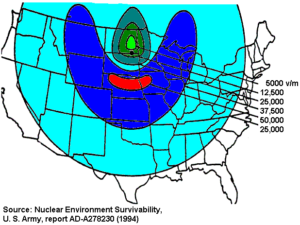… Without Being Noticed.
A bit over the top, but an interesting read of you’re so inclined.
A bit over the top, but an interesting read of you’re so inclined.

An electromagnetic pulse (EMP) is a huge energy burst that can “fry” electrical wiring and all electrical components over hundreds or even thousands of miles, making them useless and not repairable. An EMP can “kill” the computers that run our national electrical grid, as well as our cell phones AND our land line phones, TV’s, airplanes, and all cars that contain computer chips (all cars made since about 1980).
After a strong EMP, the lights won’t come on. Pocahontas Water Works won’t be pumping water. Texas won’t be pumping natural gas to us. The hospital’s backup generator will probably be fried, and they and the pharmacies will face people pressing at the doors for whatever drugs are left in stock.
Businesses don’t stock huge inventories anymore. They depend on 2nd-day delivery to keep them from running out of things, and those deliveries will stop. Food delivery to stores will stop. Refrigeration will be a thing of the past until the power comes back on, and that could take months or even years.
And that’s just the beginning.
Think of it this way: if an enemy’s 10 large nuclear weapons wiped out America’s 10 largest cities, the gasoline generators in Pocahontas would still work, our cars would still work, our electrical devices would still work and we’d be in fairly good shape, just waiting for the electricity to come back on. But ONE well-placed nuclear weapon 200 miles above mid-America could shut down our whole country, potentially for years, because even if you get the power on, the electrical components in the devices are fried and won’t work. And the companies and their machines that could manufacture new devices are fried, too.
An EMP can be generated by strong solar flares (sun spots) or a burst of electromagnetic radiation created by small-but-optimized nuclear explosions high in the atmosphere. The resulting rapidly changing electric and magnetic fields may couple with electrical and electronic systems to produce devastating current and voltage surges over a huge area. Such an optimized EMP device is probably the world’s most devastating weapon, and most people aren’t even aware such devices exist.
In July 1962, the US carried out the Starfish Prime test, exploding a 1.44 megaton bomb, small by modern standards, 250 miles above the mid-Pacific Ocean. This demonstrated that the effects of a high-altitude nuclear explosion were much larger than had been previously calculated. Starfish Prime made those effects known to the public by causing electrical damage in Hawaii, about 900 miles away from the detonation point, knocking out about 300 streetlights, setting off numerous burglar alarms and damaging a microwave link.
In 1962, the Soviet Union also performed three EMP-producing nuclear tests in space over Kazakhstan, the last in the “Soviet Project K nuclear tests”. Although these weapons were much smaller (300 kiloton) than the Starfish Prime test, they were over a populated, large land mass and at a location where the Earth’s magnetic field was greater; the damage caused by the resulting EMP was reportedly much greater than in Starfish Prime. The geomagnetic storm–like E3 pulse from Test 184 induced a current surge in a long underground power line that caused a fire in the power plant in the city of Karaganda.
For one of the K Project tests, Soviet scientists instrumented a 350 mile section of telephone line in the area that they expected to be affected by the pulse. The monitored telephone line was divided into sub-lines of 25 to 50 miles in length, separated by repeaters. Each sub-line was protected by fuses and by gas-filled overvoltage protectors. The EMP from Test 184 blew all of the fuses and fired all of the overvoltage protectors in all of the sub-lines.

Published reports, including a 1998 IEEE article, have stated that there were significant problems with ceramic insulators on overhead electrical power lines during the tests. A 2010 technical report written for Oak Ridge National Laboratory stated that “Power line insulators were damaged, resulting in a short circuit on the line and some lines detaching from the poles and falling to the ground.”
The E1 pulse is the very fast component of nuclear EMP. E1 is a very brief but intense electromagnetic field that induces very high voltages in electrical conductors. E1 causes most of its damage by causing electrical breakdown voltages to be exceeded. E1 can destroy computers and communications equipment and it changes too quickly (nanoseconds) for ordinary surge protectors to provide effective protection against it.
Older, vacuum tube based equipment is generally much less vulnerable to nuclear EMP than solid state equipment, which is much more susceptible to damage by large but brief voltage and current surges. Soviet Cold War-era military aircraft often had avionics based on vacuum tubes because solid-state capabilities were limited and vacuum-tube gear was believed to be more likely to survive.
Here are just a few ways an EMP-optimized device could be used against the USA:
It’s feared that a terrorist group or nuclear-equipped country could severely cripple the USA, in effect winning a war against us in seconds, by exploding a few nuclear devices high over the US, perhaps launched from cargo ships off the East, West, and Gulf of Mexico coasts. Such an attack has the potential to destroy our nation’s electrical system, as well as “frying” every electrical device from our computers to the microchips controlling our cars and airplanes. In an instant we could find ourselves back in the Victorian Era, relying on steam engines and horsepower from real horses. This is why we prepare.
 An interesting article worth reading: http://www.survivopedia.com/heat-home-electricity
An interesting article worth reading: http://www.survivopedia.com/heat-home-electricity